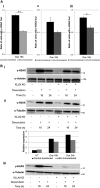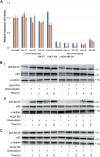KLLN-mediated DNA damage-induced apoptosis is associated with regulation of p53 phosphorylation and acetylation in breast cancer cells
- PMID: 30245854
- PMCID: PMC6134104
- DOI: 10.1038/s41420-018-0094-x
KLLN-mediated DNA damage-induced apoptosis is associated with regulation of p53 phosphorylation and acetylation in breast cancer cells
Erratum in
-
Erratum: Publisher Correction: articles initially published in wrong volume.Cell Death Discov. 2019 Jul 10;5:116. doi: 10.1038/s41420-019-0186-2. eCollection 2019. Cell Death Discov. 2019. PMID: 31312525 Free PMC article.
Abstract
KLLN is a target of p53 involved in S-phase cell cycle regulation deemed necessary and sufficient for p53-mediated apoptosis. Germline promoter hypermethylation of KLLN is associated with a cancer-predisposition syndrome, Cowden syndrome. KLLN's DNA-binding ability is associated with transcription regulation and maintenance of genomic stability. Here, we report on KLLN's role in DNA damage response (DDR) mediated through apoptosis in breast cells with and without a cancer phenotype. KLLN expression was upregulated after doxorubicin-induced DNA damage and this upregulation can be abrogated using RNAi-mediated gene silencing. Silencing KLLN after doxorubicin treatment effected DDR shown by decreased γ-H2AX foci and expression, and apoptosis assessed by decreased frequency of apoptotic nuclei and decreased expression of definitive markers of apoptosis. Contrary to expectations, there was no change in cell cycle regulation after KLLN silencing. These results were observed in breast cells with wildtype and mutant p53. At early timepoints after doxorubicin treatment, knocking down KLLN resulted in decreased Ser15-phosphorylation of p53 but not Thr68-phosphorylation of CHK2 or the phosphorylation of upstream regulators such as ATM and ATR. Interestingly, a second pathway for p53 activation was also affected by knockdown of KLLN. After doxorubicin treatment, Thr454-phosphorylation of DBC1, required to inhibit deacetylation of p53 by SIRT1, was decreased and therefore acetylation of p53 was also decreased with KLLN knockdown. Therefore, our observations suggest that KLLN's role in DNA damage-induced apoptosis is likely independent of p53 and is associated with a two-pronged regulation of p53 activation.
Conflict of interest statement
The authors declare that they have no conflict of interest.
Figures







References
LinkOut - more resources
Full Text Sources
Other Literature Sources
Medical
Molecular Biology Databases
Research Materials
Miscellaneous

